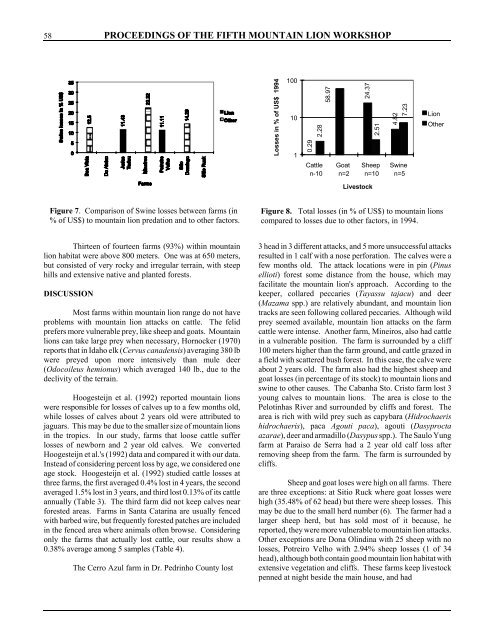Proceedings of the fifth mountain lion workshop: 27
Proceedings of the fifth mountain lion workshop: 27
Proceedings of the fifth mountain lion workshop: 27
You also want an ePaper? Increase the reach of your titles
YUMPU automatically turns print PDFs into web optimized ePapers that Google loves.
58 PROCEEDINGS OF THE FIFTH MOUNTAIN LION WORKSHOP<br />
Figure 7. Comparison <strong>of</strong> Swine losses between farms (in<br />
% <strong>of</strong> US$) to <strong>mountain</strong> <strong>lion</strong> predation and to o<strong>the</strong>r factors.<br />
Thirteen <strong>of</strong> fourteen farms (93%) within <strong>mountain</strong><br />
<strong>lion</strong> habitat were above 800 meters. One was at 650 meters,<br />
but consisted <strong>of</strong> very rocky and irregular terrain, with steep<br />
hills and extensive native and planted forests.<br />
DISCUSSION<br />
Most farms within <strong>mountain</strong> <strong>lion</strong> range do not have<br />
problems with <strong>mountain</strong> <strong>lion</strong> attacks on cattle. The felid<br />
prefers more vulnerable prey, like sheep and goats. Mountain<br />
<strong>lion</strong>s can take large prey when necessary, Hornocker (1970)<br />
reports that in Idaho elk (Cervus canadensis) averaging 380 lb<br />
were preyed upon more intensively than mule deer<br />
(Odocoileus hemionus) which averaged 140 lb., due to <strong>the</strong><br />
declivity <strong>of</strong> <strong>the</strong> terrain.<br />
Hoogesteijn et al. (1992) reported <strong>mountain</strong> <strong>lion</strong>s<br />
were responsible for losses <strong>of</strong> calves up to a few months old,<br />
while losses <strong>of</strong> calves about 2 years old were attributed to<br />
jaguars. This may be due to <strong>the</strong> smaller size <strong>of</strong> <strong>mountain</strong> <strong>lion</strong>s<br />
in <strong>the</strong> tropics. In our study, farms that loose cattle suffer<br />
losses <strong>of</strong> newborn and 2 year old calves. We converted<br />
Hoogesteijn et al.'s (1992) data and compared it with our data.<br />
Instead <strong>of</strong> considering percent loss by age, we considered one<br />
age stock. Hoogesteijn et al. (1992) studied cattle losses at<br />
three farms, <strong>the</strong> first averaged 0.4% lost in 4 years, <strong>the</strong> second<br />
averaged 1.5% lost in 3 years, and third lost 0.13% <strong>of</strong> its cattle<br />
annually (Table 3). The third farm did not keep calves near<br />
forested areas. Farms in Santa Catarina are usually fenced<br />
with barbed wire, but frequently forested patches are included<br />
in <strong>the</strong> fenced area where animals <strong>of</strong>ten browse. Considering<br />
only <strong>the</strong> farms that actually lost cattle, our results show a<br />
0.38% average among 5 samples (Table 4).<br />
The Cerro Azul farm in Dr. Pedrinho County lost<br />
Losses in % <strong>of</strong> US$ 1994<br />
100<br />
10<br />
1<br />
0.29<br />
2.28<br />
Cattle<br />
n-10<br />
58.97<br />
Goat<br />
n=2<br />
24.37<br />
2.51<br />
Sheep<br />
n=10<br />
Livestock<br />
4.82<br />
7.23<br />
Swine<br />
n=5<br />
Lion<br />
O<strong>the</strong>r<br />
Figure 8. Total losses (in % <strong>of</strong> US$) to <strong>mountain</strong> <strong>lion</strong>s<br />
compared to losses due to o<strong>the</strong>r factors, in 1994.<br />
3 head in 3 different attacks, and 5 more unsuccessful attacks<br />
resulted in 1 calf with a nose perforation. The calves were a<br />
few months old. The attack locations were in pin (Pinus<br />
ellioti) forest some distance from <strong>the</strong> house, which may<br />
facilitate <strong>the</strong> <strong>mountain</strong> <strong>lion</strong>'s approach. According to <strong>the</strong><br />
keeper, collared peccaries (Tayassu tajacu) and deer<br />
(Mazama spp.) are relatively abundant, and <strong>mountain</strong> <strong>lion</strong><br />
tracks are seen following collared peccaries. Although wild<br />
prey seemed available, <strong>mountain</strong> <strong>lion</strong> attacks on <strong>the</strong> farm<br />
cattle were intense. Ano<strong>the</strong>r farm, Mineiros, also had cattle<br />
in a vulnerable position. The farm is surrounded by a cliff<br />
100 meters higher than <strong>the</strong> farm ground, and cattle grazed in<br />
a field with scattered bush forest. In this case, <strong>the</strong> calve were<br />
about 2 years old. The farm also had <strong>the</strong> highest sheep and<br />
goat losses (in percentage <strong>of</strong> its stock) to <strong>mountain</strong> <strong>lion</strong>s and<br />
swine to o<strong>the</strong>r causes. The Cabanha Sto. Cristo farm lost 3<br />
young calves to <strong>mountain</strong> <strong>lion</strong>s. The area is close to <strong>the</strong><br />
Pelotinhas River and surrounded by cliffs and forest. The<br />
area is rich with wild prey such as capybara (Hidrochaeris<br />
hidrochaeris), paca Agouti paca), agouti (Dasyprocta<br />
azarae), deer and armadillo (Dasypus spp.). The Saulo Yung<br />
farm at Paraiso de Serra had a 2 year old calf loss after<br />
removing sheep from <strong>the</strong> farm. The farm is surrounded by<br />
cliffs.<br />
Sheep and goat loses were high on all farms. There<br />
are three exceptions: at Sitio Ruck where goat losses were<br />
high (35.48% <strong>of</strong> 62 head) but <strong>the</strong>re were sheep losses. This<br />
may be due to <strong>the</strong> small herd number (6). The farmer had a<br />
larger sheep herd, but has sold most <strong>of</strong> it because, he<br />
reported, <strong>the</strong>y were more vulnerable to <strong>mountain</strong> <strong>lion</strong> attacks.<br />
O<strong>the</strong>r exceptions are Dona Olindina with 25 sheep with no<br />
losses, Potreiro Velho with 2.94% sheep losses (1 <strong>of</strong> 34<br />
head), although both contain good <strong>mountain</strong> <strong>lion</strong> habitat with<br />
extensive vegetation and cliffs. These farms keep livestock<br />
penned at night beside <strong>the</strong> main house, and had

















